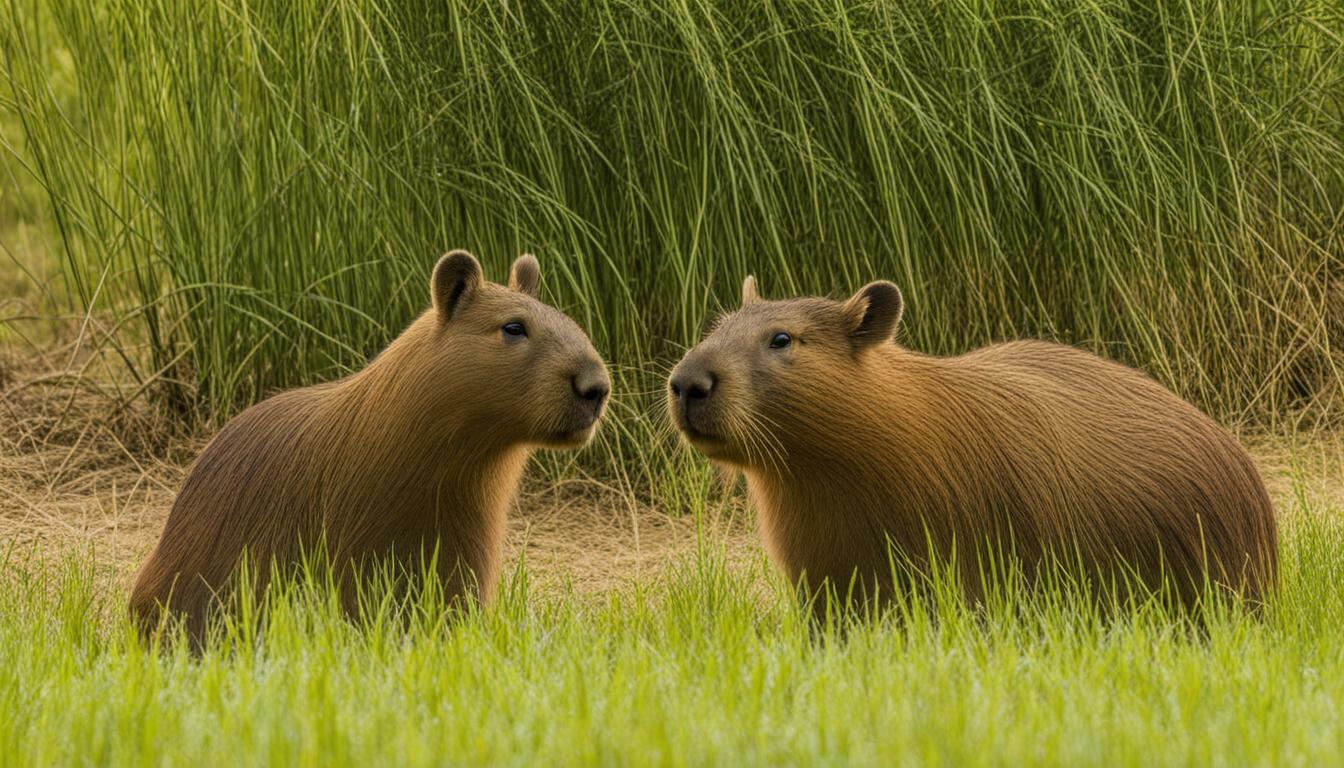Capybaras, the largest rodents in the world, have developed effective defense mechanisms to protect themselves from potential predators. They rely on a combination of physical attributes and strategic behaviors to ensure their safety in their natural habitats.
Key Takeaways:
- Capybaras use their powerful teeth and agility to escape from predators.
- Diving into water allows capybaras to create a barrier between themselves and their predators.
- Their impressive running speed of up to 8 km/h helps capybaras outrun most predators.
- Capybaras utilize the environment, such as dense vegetation near water sources, for camouflage and protection.
- Quick reflexes and the ability to sense danger enable capybaras to react swiftly and escape from potential threats.
Capybara Teeth and Agility
One of the primary defense mechanisms of capybaras is their sharp teeth and remarkable agility. Capybaras have large incisors that continuously grow, similar to rodents, allowing them to bite down and cause significant damage to predators. Their teeth are designed for cutting through tough vegetation as well as defending themselves when necessary. These powerful teeth serve as a deterrent to predators, as they can inflict painful bites if threatened.
In addition to their teeth, capybaras are incredibly agile animals. They have a streamlined body shape and strong limbs that enable them to navigate various terrains with ease. Their highly developed muscles make them excellent swimmers and allow them to swiftly escape predators by diving into water. Capybaras can stay submerged for several minutes, using their aquatic abilities as a natural barrier and safety measure.
The combination of sharp teeth and agility gives capybaras an advantage when defending themselves against predators. They have the ability to swiftly react to threats by either delivering powerful bites or quickly escaping into the water. These defense strategies, along with their social nature and other physical attributes, contribute to the capybara’s overall survival in their natural habitats.
| Defense Mechanism | Advantages |
|---|---|
| Sharp Teeth | Effective for warding off predators |
| Agility | Enables them to escape and navigate their environment |
| Swimming Ability | Provides them with a natural barrier and escape route |
| Social Groups | Strength in numbers and collective defense |
In summary, capybaras possess sharp teeth and remarkable agility as their primary defense mechanisms. These physical attributes, along with their swimming abilities, social behavior, and adaptability to their environment, greatly contribute to their overall survival and ability to defend themselves against predators.
Diving Into Water as a Barrier
When confronted with danger, capybaras can quickly dive into the water, using it as a natural barrier between themselves and their predators. This ability comes from their adaptability to an aquatic lifestyle. Capybaras are excellent swimmers, with webbed feet that allow them to navigate through water with ease. They can submerge themselves completely, only revealing their eyes, nose, and ears above the water’s surface.
By diving into the water, capybaras not only create distance between themselves and potential threats but also make it harder for predators to locate them. Their brownish fur blends in with the surroundings, providing camouflage. Additionally, capybaras can stay underwater for several minutes, which gives them an advantage when it comes to evading predators.
Another benefit of using water as a protective barrier is that capybaras can retreat to deeper areas if necessary. They can swim to safety in deeper waters, where larger predators may find it more difficult to navigate. This strategy allows capybaras to escape danger and protect themselves effectively.
| Safety Strategy | Advantages |
|---|---|
| Diving into water | Creates distance from predators |
| Camouflage in water | Provides a natural hiding place |
| Ability to stay underwater | Makes it harder for predators to locate |
| Retreating to deeper waters | Escaping larger predators |
In conclusion, capybaras have developed unique protection techniques, and diving into water is one of their most effective strategies. This ability to use water as a barrier not only helps them create distance from predators but also provides a natural camouflage and escape route. By utilizing their aquatic skills, capybaras can successfully avoid danger and ensure their survival in their natural habitat.
Swift Running Speed
Capybaras are fast runners, reaching speeds of up to 8 km/h, allowing them to outpace most predators. This remarkable agility is a crucial aspect of their self-defense strategy. When faced with danger, capybaras rely on their ability to quickly flee from potential threats. Their swift running speed enables them to create distance between themselves and predators, minimizing the risk of being caught.
By harnessing their speed, capybaras can effectively evade pursuing predators, whether they are on land or near water sources. This survival instinct is particularly useful in open areas where their natural camouflage becomes less effective. By utilizing their quick running ability, capybaras can make a swift exit and seek refuge in denser vegetation or near the safety of water.
You might be surprised to learn that capybaras are actually excellent swimmers as well. While they primarily reside near water bodies, they are equally comfortable in the water as they are on land. By combining their running speed with their aquatic agility, capybaras have an additional advantage over predators. In the event of an imminent threat, capybaras can swiftly retreat into water, using it as a barrier between themselves and their pursuers.
| Defense Strategy | Effectiveness |
|---|---|
| Swift running speed | High |
| Utilizing water as a barrier | High |
| Ability to swim | High |
In summary, the swift running speed of capybaras, coupled with their ability to swim and use water as a protective barrier, greatly enhances their chances of survival against potential predators. These unique capabilities, combined with their adaptation to live in social groups and their keen senses, make capybaras formidable when it comes to self-defense. These remarkable creatures employ a comprehensive approach to ensure their safety in their natural habitat.
Utilizing the Environment
Capybaras have evolved to hide in dense vegetation near water sources, using their environment as a natural camouflage. This allows them to blend seamlessly with their surroundings, making it difficult for predators to spot them. By taking advantage of their habitat, capybaras increase their chances of avoiding detection and remaining safe from harm.
In addition to using vegetation for camouflage, capybaras also utilize their environment as a means of escape. When a potential threat approaches, capybaras will quickly retreat to the safety of the water. Their excellent swimming abilities and the presence of water provide an effective barrier between themselves and their predators. Capybaras can stay submerged for several minutes, effectively thwarting any attempts by predators to reach them.
Furthermore, the dense vegetation and water sources that capybaras rely on for protection also serve as a source of food. These semi-aquatic rodents are herbivores and primarily feed on aquatic plants and grasses found near the water. By staying near their food sources, capybaras can ensure they have easy access to both sustenance and protection.
| Environment | Advantage |
|---|---|
| Dense vegetation | Provides natural camouflage |
| Water sources | Creates a barrier between capybaras and predators |
| Food sources | Ensures easy access to sustenance and protection |
In summary, capybaras have developed remarkable strategies for utilizing their environment to their advantage. By hiding in dense vegetation near water sources, they can effectively camouflage themselves, escape into the water when necessary, and ensure a steady supply of food. These techniques, combined with their physical defenses and social behavior, enable capybaras to thrive in their natural habitats while protecting themselves from potential predators.
Quick Reflexes and Threat Response
With their sharp senses and quick reflexes, capybaras can detect threats and react promptly to evade predators. Their acute hearing and excellent eyesight allow them to spot danger from a distance, giving them the advantage of time to respond. When a potential threat is detected, capybaras can react in various ways to ensure their safety.
“Capybaras have an incredible ability to sense danger and respond swiftly,” says Dr. Amanda Rodriguez, a wildlife biologist specializing in capybara behavior. “Their quick reflexes and threat response mechanisms have evolved over time as a survival strategy.”
One of the ways capybaras respond to threats is by fleeing. Their strong hind legs allow them to swiftly run away from danger, reaching speeds of up to 8 km/h. This speed, combined with their agility, makes them difficult to catch for most predators. Capybaras can also take advantage of their environment by seeking cover in dense vegetation near water sources, where they can camouflage themselves and remain hidden from potential predators.
When faced with a predator, capybaras might also emit distinctive alarm calls to alert others in their social group of the impending danger. These calls include barks, whistles, clicks, squeals, and grunts. By communicating with each other, capybaras can collectively coordinate their response to threats, increasing their chances of survival.
The Capybara’s Defense Mechanisms Explained
In summary, capybaras have evolved effective defense mechanisms that allow them to thrive in their natural habitats. With their sharp senses, quick reflexes, and ability to detect threats, capybaras can promptly respond and evade predators. Their speed and agility, coupled with their environment utilization, provide them with additional layers of protection. Furthermore, their communication methods and social group living enhance their collective defense strategies. By employing a combination of physical defenses, threat response mechanisms, and collaborative behaviors, capybaras have established themselves as highly adaptable and successful survivors in their ecosystem.
| Defense Mechanisms | Description |
|---|---|
| Senses and Reflexes | Sharp senses and quick reflexes enable capybaras to detect threats and react promptly. |
| Speed and Agility | Capybaras can outrun most predators with their running speed of up to 8 km/h. |
| Environment Utilization | Hiding in dense vegetation near water sources provides camouflage and protection. |
| Communication and Collective Defense | Alarm calls and group coordination enhance capybaras’ protection strategies. |
Communication Methods
Capybaras communicate through a variety of vocalizations, including barks, whistles, clicks, squeals, and grunts, to warn others of potential dangers. These vocalizations serve as an essential defense mechanism, allowing capybaras to alert their group members about the presence of predators or other threats in their surroundings. By emitting distinct sounds, capybaras can effectively communicate the need for caution and increased vigilance.
In addition to vocalizations, capybaras also employ non-verbal communication methods to enhance their collective defense. They use body language, such as raised or twitching ears, to indicate possible danger. By observing the behavior of their peers, capybaras can quickly determine if there is a potential threat nearby.
Group Dynamics and Safety
Living in social groups provides capybaras with an added layer of protection against predators. By staying close to their group members, capybaras can not only increase their chances of detecting potential threats but also benefit from the collective defense strategies of their companions.
In times of danger, capybaras will huddle together, forming a tight-knit group known as a “capybara stack.” This formation makes it difficult for predators to target a single individual, as their combined size and numbers create a formidable barrier of protection. Their size and strong social bonds within the group act as deterrents, often repelling predators and keeping the capybaras safe.
| Communication Methods | Benefits |
|---|---|
| Vocalizations (barks, whistles, clicks, squeals, and grunts) | Warns others of potential dangers |
| Non-verbal cues (raised or twitching ears) | Indicates possible danger |
| Group dynamics and living in social groups | Enhances collective defense and safety |
Strength in Numbers – Living in Social Groups
Capybaras form social groups, providing safety in numbers and increased vigilance against potential threats. These groups consist of several individuals, typically led by a dominant male, known as the alpha male, and are composed of females and their offspring. Living together in a group allows capybaras to share the responsibility of detecting and warding off predators.
In addition to safety, social groups also offer capybaras a sense of companionship and cooperation. They engage in grooming, social bonding, and vocal communication, reinforcing their strong social structure. By living in close proximity to each other, capybaras can quickly alert the group if they sense danger, allowing others to respond and escape together.
Increased Vigilance and Cooperation
The vigilance of capybaras is heightened when in a social group. They take turns being on lookout duty, scanning the surroundings for any signs of predators. This increased vigilance and cooperation provide a crucial advantage in detecting potential threats early and taking appropriate action to avoid them.
When a predator is spotted, capybaras in the group emit warning calls, alerting others to the imminent danger. These warning calls can take the form of barks, whistles, clicks, squeals, and grunts. By communicating effectively, capybaras can coordinate their response and increase their chances of escaping unharmed.
| Advantages of Social Group Living | Disadvantages of Social Group Living |
|---|---|
|
|
Living in groups provides capybaras with numerous advantages, but it also has its drawbacks. Increased competition for resources, such as food and shelter, can arise within the group. Additionally, being in close proximity to each other increases the risk of disease transmission. However, despite these challenges, the benefits of living in a social group far outweigh the disadvantages, ensuring capybaras have a better chance of survival in their natural habitat.
Physical Defenses
Alongside their teeth and agility, capybaras have physical defenses such as tough skin and sharp claws, which can be used to fend off predators. Their skin is thick and leathery, providing a protective barrier against potential threats. Capybaras are covered in coarse hair, which adds an extra layer of defense. They also have sharp, strong claws that they can use to scratch or bite attackers, inflicting injuries that can deter predators.
In addition to their physical attributes, capybaras have a unique adaptation known as “crests” on their back. These crests are made of cartilage and act as a protective shield, offering extra defense against bites and attacks to their vulnerable spinal cord.
When faced with danger, capybaras can use these physical defenses to fight back or escape. Their combination of teeth, agility, tough skin, sharp claws, and protective crests make them formidable opponents for predators in their habitats.
The Physical Defenses of Capybaras:
1. Tough Skin: Capybaras have thick, leathery skin that acts as a natural armor, providing protection against predators.
2. Sharp Claws: The capybara’s sharp, strong claws can be used to scratch or bite attackers, inflicting injuries that can deter predators.
3. Crests: Capybaras have cartilage crests on their back that act as a protective shield, offering extra defense against bites and attacks to their vulnerable spinal cord.
| Defense Mechanism | Description |
|---|---|
| Tough Skin | Thick and leathery skin that provides a protective barrier against potential threats. |
| Sharp Claws | Strong claws that can be used for scratching or biting attackers, inflicting injuries to deter predators. |
| Crests | Cartilage crests on the back that act as a shield, offering extra defense against bites and attacks to the spinal cord. |
With their physical defenses, capybaras can effectively defend themselves against predators. These adaptations, combined with their other defense mechanisms, ensure their survival in their natural environment. Capybaras are truly fascinating creatures with a range of strategies that contribute to their ability to thrive despite the presence of potential threats.
Summary of Defense Strategies
Capybaras employ a combination of physical defenses, speed, environmental strategies, communication, and living in social groups to ensure their safety from predators.
They have powerful teeth and agility, which they use to escape from predators. Their ability to dive into water and use it as a barrier helps protect them from potential threats. Capybaras are also known for their impressive running speed, reaching up to 8 km/h, allowing them to outrun most predators in their habitat.
By utilizing their environment, capybaras can hide in dense vegetation near water sources, making it difficult for predators to spot them. Their quick reflexes and ability to sense danger enable capybaras to react swiftly and escape from potential harm.
Capybaras communicate with each other using various sounds such as barks, whistles, clicks, squeals, and grunts. This helps them stay connected and alert each other about potential dangers. They also live in social groups, providing them with strength in numbers and increasing their chances of survival.
| Defense Strategies | Description |
|---|---|
| Physical Defenses | Powerful teeth and agility |
| Utilizing Water | Diving into water as a barrier |
| Running Speed | Impressive running speed of up to 8 km/h |
| Environmental Strategies | Utilizing the surroundings for protection |
| Quick Reflexes | Ability to sense danger and react swiftly |
| Communication | Barks, whistles, clicks, squeals, and grunts |
| Living in Social Groups | Strength in numbers for protection |
Capybaras and Predator Avoidance
Through their defense mechanisms and survival strategies, capybaras have become adept at avoiding predators in the wild. These herbivorous rodents have several clever methods to stay one step ahead of their would-be attackers.
Firstly, capybaras rely on their powerful teeth and agility to escape from predators. Their sharp incisors allow them to deliver a formidable bite if necessary, while their ability to quickly navigate through dense vegetation and their exceptional swimming skills enable them to evade capture.
Furthermore, capybaras can dive into water and use it as a protective barrier between themselves and their predators. With their ability to hold their breath for up to five minutes, these semi-aquatic creatures can disappear beneath the water’s surface to hide from predators or make a quick escape when necessary.
In addition, capybaras are fast runners, reaching speeds of up to 8 km/h. This impressive speed allows them to outrun most predators, ensuring their safety in open areas. They can also use their environment to their advantage, hiding in dense vegetation near water sources, which provides them with additional cover and protection.
Communicating with each other is also a crucial aspect of capybara defense. Capybaras use an array of vocalizations, including barks, whistles, clicks, squeals, and grunts, to alert their group members of potential danger and coordinate their actions to evade predators effectively.
Living in social groups provides capybaras with added protection against predators. By living in large family units, capybaras can increase their overall vigilance, making it easier to spot approaching predators and respond as a group to avoid becoming a target. Strength in numbers significantly reduces their individual risk.
Overall, with their physical defenses, exceptional speed, strategic use of their environment, effective communication methods, and the power of their collective group, capybaras have developed a range of survival tactics that help them skillfully avoid predators in their natural habitats.
| Defense Mechanism | Benefits |
|---|---|
| Powerful teeth and agility | Allows capybaras to escape from predators |
| Diving into water | Creates a protective barrier |
| Swift running speed | Enables capybaras to outrun most predators |
| Utilizing the environment | Provides additional cover and protection |
| Quick reflexes and threat response | Help capybaras sense danger and react swiftly |
| Communication methods | Enhances group coordination and vigilance |
| Strength in numbers | Reduces individual risk |
Conclusion
Capybaras, with their innate defense mechanisms, adaptability, and strong survival instincts, demonstrate a remarkable ability to protect themselves from predators in their natural habitats.
These fascinating creatures rely on a combination of physical defenses, agility, and astute strategies to ensure their safety. Their sharp teeth and nimble movements allow them to escape from potential predators, while their ability to dive into water provides an effective barrier against threats.
Speed also plays a crucial role in capybaras’ defense tactics. With a running speed of up to 8 km/h, they can outpace most predators, giving themselves a substantial advantage.
In addition to their physical attributes, capybaras have evolved to make the most of their environment. By hiding in dense vegetation near water sources, they can effectively camouflage themselves from potential threats. Their keen senses and quick reflexes enable them to sense danger and react swiftly, ensuring their survival.
Communication is another vital aspect of capybara defense. Capybaras utilize a range of vocalizations including barks, whistles, clicks, squeals, and grunts to communicate with each other, enhancing their collective defense and alerting others to potential danger.
Living in social groups also contributes to their protection. By banding together, capybaras increase their chances of detecting predators early and deterring them with their collective strength.
Overall, capybaras have developed a comprehensive set of defense mechanisms that enable them to thrive in their environments. From their physical attributes to their adaptive behaviors, these remarkable creatures have mastered the art of self-preservation and serve as a testament to the wonders of the animal kingdom.
FAQ
How do capybaras defend themselves?
Capybaras have several defense mechanisms to protect themselves from predators. They rely on their powerful teeth and agility to escape, can dive into water as a barrier, are fast runners, utilize their environment for hiding, have quick reflexes, communicate with various sounds, and live in social groups for protection.
What physical defenses do capybaras have?
Capybaras possess powerful teeth that they can use to defend themselves from predators. They also have agility, allowing them to quickly evade danger.
How do capybaras use water as a defense mechanism?
Capybaras can dive into water to create a barrier between themselves and their predators. This makes it difficult for predators to reach them and gives capybaras an advantage in escaping.
How fast can capybaras run?
Capybaras are fast runners and can reach speeds of up to 8 km/h. This speed allows them to outrun most predators and increase their chances of survival.
How do capybaras use their environment for protection?
Capybaras hide in dense vegetation near water sources, using their surroundings as a form of camouflage and protection from predators.
Do capybaras have quick reflexes?
Yes, capybaras have quick reflexes and can sense danger. They react swiftly to threats, allowing them to escape before predators can catch them.
How do capybaras communicate with each other?
Capybaras communicate through various sounds such as barks, whistles, clicks, squeals, and grunts. This helps them alert each other to potential dangers and coordinate defensive actions.
Why do capybaras live in social groups?
Capybaras live in social groups to provide protection. When facing predators, their collective defense can be stronger, and there is safety in numbers.
What are the main defense strategies of capybaras?
Capybaras utilize a combination of physical defenses, speed, environmental strategies, quick reflexes, communication, and living in social groups to defend themselves against predators.
How do capybaras avoid predators?
Capybaras have adapted to avoid predators by using their physical defenses, speed, agility, and ability to sense danger. They also take advantage of their environment and live in social groups for protection.




